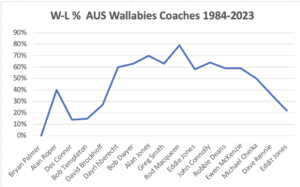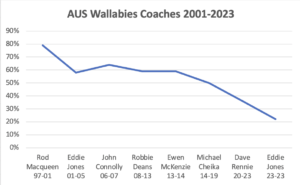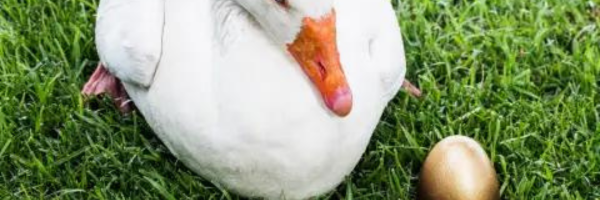A score of declining performance
The 2023 Rugby World Cup performance ranked as the Australian ‘Wallabies’ worst performance in the ten World Cups to date in the competition’s relatively short history. Australia failed to advance out of Pool C, winning only two games and finishing 3rd in the pool. The commentary from all levels of rugby, both within and outside of Australia, was understandably critical.[1]
Many appeared to be surprised by the result. However, from a trajectory perspective, it was a confirmation of direction. The Australian ‘Wallaby’ results at international level have shown an almost linear decline since the early 2000s. That, in earlier European languages, would be described as a ‘score’ of declining results i.e., 20 years.
Without having access to extensive statistics showing twenty-year time frames for comparison purposes, one could assume such a linear decline is uncommon. If for no other reason somewhere along the way action could be expected to have been taken to halt and reverse the trend.
This creates what could be described as the key question – how does a sporting organization achieve such a long-term, linear decline in performance?
Three variables will be reviewed to demonstrate the long-term trajectory of the Australian Wallabies:
- World ranking
- Wallaby Coach’s win-loss percentage
- Bledisloe Cup results
World rankings
The Rugby world rankings were introduced in late 2003 for the World Cup of that year, and records have been maintained since. The 2004 to 2023 results are shown below and demonstrate a relatively linear decline across those twenty years.

Wallaby Coach win-loss percentages
The win-loss percentages of all Australian coaches dating back to the 1960s, since records were maintained and accessible, are shared below.[2] One could divide this sixty plus year time frame into two – a rise to the peak in 2001, and a strong linear decline in the subsequent 22 years.

To demonstrate this post-2001 decline, a table and graph dedicated to this period is included. [3]
| Years | Wallaby Coach | W-L %age |
| 1997-2001 | Rod Macqueen | 79% |
| 2001-2005 | Eddie Jones | 58% |
| 2006-2007 | John Connolly | 64% |
| 2008-2013 | Robbie Deans | 59% |
| 2013-2014 | Ewen McKenzie | 59% |
| 2014-2019 | Michael Cheika | 50% |
| 2020-2023 | Dave Rennie | 36% |
| 2023-2023 | Eddie Jones | 22% |

Bledisloe Cup results
The Bledisloe Cup is a completion between the Australian Wallabies and the New Zealand All Blacks that commenced in the early 1930s.[4] It has not always been an annual event, but in recent history it has. It is essentially the outcome of a two to four game series in any calendar year. Australia is blessed with its geographical proximity to arguable the greatest national rugby team in the history of the game in the All Blacks. Whilst the All Blacks cannot be expected to be the best team in the world every year, they provide a yard-stick for Australia to assess their current status.
The last time the Australia Wallabies won the Bledisloe Cup was in 2002, and that was through a drawn series, allowing the incumbent to hold the title. Therefore, it’s been 22 years since Australia won the Bledisloe Cup.
Most losing periods for the Wallabies in this Cup history last three to five years. The previous longest losing period for the Wallabies covered thirteen years of competition from 1951 to 1978.
Summary
The three variables analyzed demonstrate a relatively linear decline in Wallaby performance over more than two decades. To put simply, no-one or nothing was successful in reversing that trend for over twenty years. That is significant.
The decline on-field success is also being seen in other areas, including declining numbers of registered players, reduced revenues, and reduced TV coverage.[5]
Some suggest there was more than on-field feedback about the need to act:
As far back as April 2010, according to confidential internal documents seen by The Australian Financial Review, Australian rugby administrators were being warned in general terms about the risks of being “blind to decline”, especially the perils of clinging to an “outdated organisational structure”….A litany of other reports followed, yet nothing changed. Today Rugby Australia resembles the last days of the Nixon White House. Yes, it is that bad. [6]
However even the on-field failures appear to have been ignored, such as the 2009 loss to Scotland at Murrayfield, the first loss to them in 27 years. This was the Australian media reaction:
Australia’s first defeat to Scotland in 27 years has been met with a storm of criticism back home – with some commentators predicting the “death of Rugby Union” Down Under…
“The Wallabies are not just the laughing stock of Australian sport. They are also the laughing stock of the international rugby world after suffering their worst loss in decades,” the Sydney Morning Herald wrote.
“This defeat was not as bad as being beaten by Tonga in 1973 but it’s not far off.”
The Australian newspaper wrote that the team’s poor performances were threatening the very support of the game in a country where four football codes – League, Union, Aussie Rules and soccer – are all fighting for fans and sponsorship.
“This Wallabies side will be the death of Australian rugby followers, if not the death of Australian rugby,” The Australian wrote.[7]
So, what did Australian Rugby do during this period of 2001 to 2023? Changed coaches. Seven coaches in total were used in that twenty-two-year period, with an average coach tenure of a little over three years. Yet the pattern of decline continued.
Accurately described by this journalist:
… post-2003, we’ve seen a cycle of coaches getting strapped into the coach’s chair and getting ejected out fighter jet style unceremoniously when glimmers of success end up unsustained.[8]
Were these ‘poor’ coaches? No, most of them were hired with resumes that supported their appointments. Were the funds so low in Australian rugby that they were forced to hire ‘cheap’ coaches? No. Many of the coaches hired were amongst the highest paid coaches in the world during their time with the Wallabies e.g., 2008 appointee Robbie Deans on a reported $1mill/year contract;[9] 2020-2023 Coach Dave Rennie reported $1mill/year.[10]
So, the coaches were not bad coaches, and they were not cheap coaches. Yet they all underperformed in the Australian coaching role, and in a linearly declining way.
The question can be asked in reverse – by studying the ‘Golden Age’ of Australian rugby:
The Guardian’s Michael Aylwin pointed out in Unholy Union, that the golden age of Australian rugby from 1979 to 1999.. [11]
Was Australian rugby excelling in the Golden Era peak of the 1990s because of the coaches?
…Then came the golden years 1984 to 2001. Eighteen seasons with an average win rate of 70%…” [12]
Or was there a different common denominator?
Many focus on the coaches, or even the players. What does history teach us? What action was taken in the 1970s to get out of the last Bledisloe slump that concluded in 1978?
“The early to mid 70s was a particularly galling era. The 1972 Wallabies were known as the “Awful Aussies…” [13]
In the 1970s Australian introduced national programs that became arguably world leading.
In 1974, Marks became the inaugural Rothmans coaching director, with responsibilities for establishing a National Coaching Scheme for Australian Rugby. He remained in the job until 1995, through an unprecedented period of success for Australian rugby.[5] He authored an influential coaching manual, instigated a number of coach and player development initiatives, and served on the first IRB Technical Committee and wrote a Charter of the Game
“What Marks achieved during his twenty-two year tenure at the job has been described with any number of accolades, but in making a judgement on his success you need go no further than the statistics. In the seven year period prior to the National Coaching Scheme, Australia had a 14% success rate over twenty-nine Test matches. By 1992 Australia had won a Grand Slam, a Bledisloe Cup series and a World Cup. Over the 110 Test matches since the introduction of the Scheme, it lifted its strike rate to 61% overall and to 72% in the last twenty nine encounters of that period.”— Peter Meares & Maxwell Howell, 2005[14]
More than one commentator can be found to reference the action taken in the 1970s to resurrect an ailing game in Australia:
Exactly 50 years ago, the Wallabies suffered one of their most notorious defeats – to Tonga in Brisbane. Yet, out of that debacle surfaced a national coaching and skills program that delivered players such as the Ella brothers, Campese and Michael Lynagh, and coaches Bob Templeton, Bob Dwyer and Alan Jones. Ultimately, they led Australia to the top of world rugby in the 1980s and ’90s.[15]
So, what happened to these programs?
“To his great credit, Mr O’Neill [ARU CEO] marketed them [the most talented and best-nurtured ever assembled in this country – and all produced under a pre-O’Neill regime very well] but to his eternal discredit he dismantled the system that produced them. He eliminated the collective system of technical policy … he took rugby out of the AIS, believing that you could buy their expertise whenever you needed it…He took the development of aspiring champions out of the hands of experienced rugby tutors and put them under the control of hacks.”[16]
Dick Marks is suggesting that the Australian Rugby Union killed the goose that laid the Golden Eggs.
Conclusion
The Australian Wallabies have demonstrated a twenty-two-year pattern of decline. Many players have been used. .Seven coaches have been used. The only constant is the Australian Rugby Union. Dick Marks accurately summed up the declining pattern of Australian rugby in his 2021 book The Descent of Australian Rugby.[17] Even the Australian Financial Review did weighed in on the issue:
Blame years of structural decline in how rugby in Australia is managed and administered. [18]
However, who in the Australian Rugby Union is taking the lessons? And what will the Australian Rugby Union produce now after 22 years of failing to reverse the decline?
Either way, the ARU deserves acknowledgement for providing an impressive case study in a score-long (twenty-year) declining performance model. And for that, all students of sports performance are grateful.
References
[1] https://www.bbc.com/sport/rugby-union/67021813
[2] https://en.wikipedia.org/wiki/Australia_national_rugby_union_team_coaches
[3] https://en.wikipedia.org/wiki/Australia_national_rugby_union_team_coaches
[4] https://en.wikipedia.org/wiki/Bledisloe_Cup
[5] https://www.smh.com.au/sport/rugby-union/weekend-at-bernie-s-why-only-radical-action-can-breathe-life-back-into-rugby-20231026-p5ef5e.html
[6] https://www.afr.com/companies/sport/at-rugby-australia-15-years-of-dithering-must-end-now-20230921-p5e6eq
[7] https://www.aljazeera.com/sports/2009/11/23/the-death-of-australian-rugby
[8] https://www.theroar.com.au/2023/11/04/the-disunion-of-australian-rugby-does-it-really-get-any-worse-than-this/
[9] http://en.espn.co.uk/scrum/rugby/story/73393.html
[10] https://www.smh.com.au/sport/rugby-union/a-rock-and-a-hard-place-rennie-s-1m-contract-under-scrutiny-20200605-p54zrn.html
[11] https://www.afr.com/companies/sport/at-rugby-australia-15-years-of-dithering-must-end-now-20230921-p5e6eq
[12] https://www.theroar.com.au/2023/07/27/golden-generations-how-australian-rugby-rose-from-obscurity-to-greatness-then-killed-green-and-golden-goose/
[13] https://www.theroar.com.au/2023/07/27/golden-generations-how-australian-rugby-rose-from-obscurity-to-greatness-then-killed-green-and-golden-goose/
[14] https://en.wikipedia.org/wiki/Dick_Marks
[15] https://www.afr.com/companies/sport/at-rugby-australia-15-years-of-dithering-must-end-now-20230921-p5e6eq
[16] https://www.foxsports.com.au/rugby/marks-questions-oneills-success/news-story/b61ecd2fea9da4788805ca548a78b5ea
[17] https://books.google.com.au/books/about/The_Descent_of_Australian_Rugby.html?id=x6kwzgEACAAJ&redir_esc=y
[18] https://www.afr.com/companies/sport/at-rugby-australia-15-years-of-dithering-must-end-now-20230921-p5e6eq



